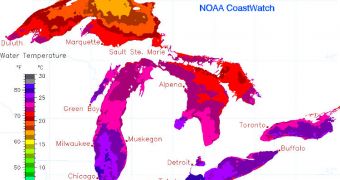The water of the five Great Lakes, at the border between the United States and Canada, displays the highest temperatures of the past century, the results of a new scientific investigation in the area show.
According to Climate Central, the waters of Cape Cod or the Outer Banks of North Carolina can be easily replaced with those of Lake Superior, until recently the coldest and deepest of the five lakes. It is also the one situated at the highest latitude.
Scientists believe that the mild winter, the warm spring, and the hot, dry summer conditions we've experienced thus far may be responsible for these unusual temperature variations. Though Lake Superior may appear chilly at 68 degrees Fahrenheit (20ºCelsius), these are actually tropical conditions.
They may not appear as such, but the fact remains that, for this region of the planet, the water in the Great Lakes should be nowhere near as warm as it is today. Statistics indicate that temperatures should lie in the mid-50s (10 to 12 degrees Celsius).
At the same time, surveys have revealed that the amount of ice present in the five Great Lakes during this winter was the lowest recorded in 30 years, since such measurements began.
“It’s pretty safe to say that what we’re seeing here is the warmest that we’ve seen in Lake Superior in a century,” University of Minnesota in Duluth professor Jay Austin explains. He was the leader of the team that investigated the long-term evolution of temperatures in the Great Lakes.
“The season hasn’t played itself out yet and we’re already within 3 degrees of the all-time daily record surface temperature,” he goes on to say. Austin adds that the characteristics of Lake Superior are constantly being monitored by buoys deployed on its surface.
Due to the fact that this is a very dry summer, harmful algal bloom have yet to develop on any of the five lakes. Last year, Lake Erie was nearly suffocated by massive blooms, which consumed most of the oxygen in the water, and caused significant damage to aquatic populations.
If water temperatures do not decrease until the beginning of the fall, then there is a significant chance that this winter will see vast volumes of snow being produced by air masses that pass above the Great Lakes. A similar occurrence took place during 2010's infamous Blizzmagedon.

 14 DAY TRIAL //
14 DAY TRIAL //